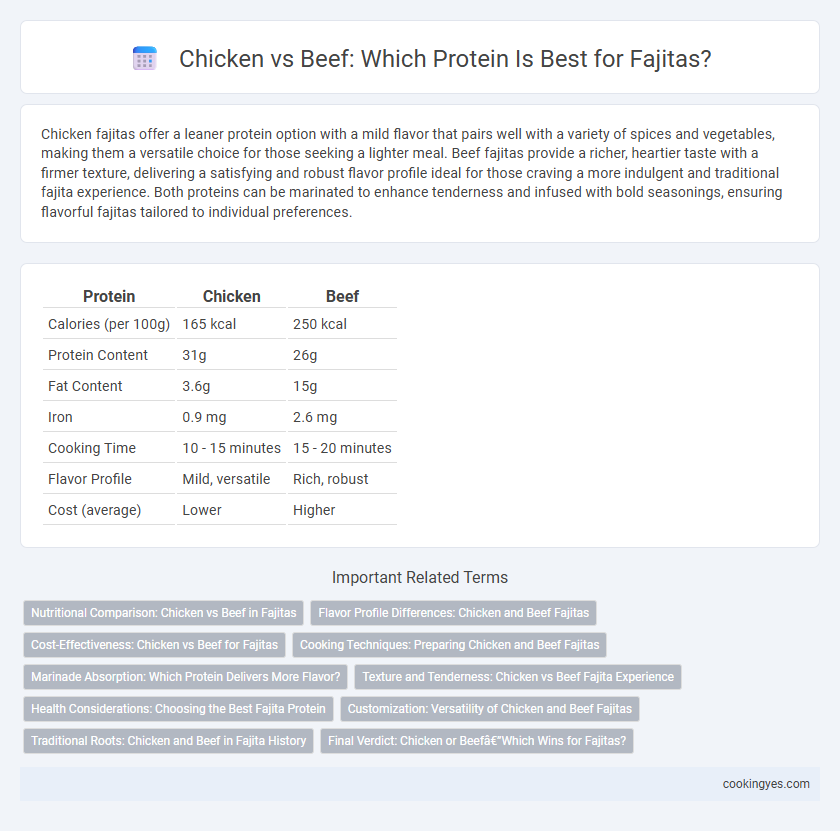Chicken fajitas offer a leaner protein option with a mild flavor that pairs well with a variety of spices and vegetables, making them a versatile choice for those seeking a lighter meal. Beef fajitas provide a richer, heartier taste with a firmer texture, delivering a satisfying and robust flavor profile ideal for those craving a more indulgent and traditional fajita experience. Both proteins can be marinated to enhance tenderness and infused with bold seasonings, ensuring flavorful fajitas tailored to individual preferences.
Table of Comparison
| Protein | Chicken | Beef |
|---|---|---|
| Calories (per 100g) | 165 kcal | 250 kcal |
| Protein Content | 31g | 26g |
| Fat Content | 3.6g | 15g |
| Iron | 0.9 mg | 2.6 mg |
| Cooking Time | 10 - 15 minutes | 15 - 20 minutes |
| Flavor Profile | Mild, versatile | Rich, robust |
| Cost (average) | Lower | Higher |
Nutritional Comparison: Chicken vs Beef in Fajitas
Chicken fajita protein offers a leaner option with approximately 165 calories and 31 grams of protein per 3.5-ounce serving, providing lower saturated fat compared to beef. Beef, while richer in iron and zinc, contains around 250 calories and higher saturated fat content per equivalent portion, impacting heart health considerations. Opting for chicken supports a lower calorie and fat intake, whereas beef enhances micronutrient density in fajita meals.
Flavor Profile Differences: Chicken and Beef Fajitas
Chicken fajitas offer a lighter, milder flavor with a subtle sweetness that absorbs marinades and spices well, creating a tender and juicy bite. Beef fajitas, often made with skirt or flank steak, deliver a richer, more robust, and savory taste with a slightly chewy texture that holds up to bold seasonings like cumin, chili powder, and smoked paprika. The choice between chicken and beef impacts the overall fajita experience, balancing tenderness and intensity to suit different flavor preferences.
Cost-Effectiveness: Chicken vs Beef for Fajitas
Chicken proves to be more cost-effective than beef for fajita protein due to its lower price per pound and greater availability in various cuts. Beef, while offering a richer flavor profile, generally carries higher costs that can impact budget-conscious meal planning. Opting for chicken in fajitas maximizes protein value without compromising taste or portion size, making it a practical choice for both restaurants and home cooks.
Cooking Techniques: Preparing Chicken and Beef Fajitas
Chicken fajitas benefit from marinating in citrus and spices for tender, juicy meat that grills quickly over high heat, sealing in moisture and enhancing flavor. Beef fajitas, typically using skirt or flank steak, require careful seasoning and are best cooked over direct heat to medium-rare for a tender, flavorful bite. Resting both proteins after cooking allows juices to redistribute, ensuring maximum tenderness in each fajita serving.
Marinade Absorption: Which Protein Delivers More Flavor?
Chicken typically absorbs marinades more effectively than beef due to its porous muscle fibers and lower fat content, which allows the flavors to penetrate deeply and evenly. Beef's denser texture and higher fat content can create a barrier, leading to a more surface-level flavor absorption primarily in cuts like skirt or flank steak used for fajitas. Consequently, chicken fajitas often deliver a more intense and well-distributed marinade flavor compared to beef.
Texture and Tenderness: Chicken vs Beef Fajita Experience
Chicken fajitas offer a tender and juicy texture that absorbs marinades well, creating a consistently soft bite with a mild flavor profile. Beef fajitas, especially when using skirt or flank steak, provide a chewier and more robust texture, delivering a satisfying hearty chew that highlights the meat's natural richness. The choice between chicken and beef protein directly impacts the fajita experience by balancing tenderness and texture according to personal preference and cooking technique.
Health Considerations: Choosing the Best Fajita Protein
Chicken fajitas offer a leaner protein option, providing lower saturated fat and calorie content compared to beef, making them favorable for heart health and weight management. Beef fajitas are richer in iron and vitamin B12, essential for energy levels and blood health, but higher in cholesterol which may impact cardiovascular risk if consumed excessively. Selecting between chicken and beef depends on individual nutritional goals, with chicken supporting reduced fat intake and beef supplying more micronutrients.
Customization: Versatility of Chicken and Beef Fajitas
Chicken fajitas offer a lean, mild-flavored protein that easily absorbs diverse marinades and spices, making them highly customizable for various taste preferences. Beef fajitas provide a rich, bold flavor and a tender texture that pairs well with robust seasonings and toppings, allowing for personalized heat levels and ingredient combinations. Both proteins cater to versatile preparation styles, enabling diners to tailor fajitas with vegetables, sauces, and seasonings to achieve their preferred culinary experience.
Traditional Roots: Chicken and Beef in Fajita History
Chicken and beef both hold significant traditional roots in fajita history, with beef originally popularized by Mexican ranch workers using skirt steak as an accessible protein. Chicken became a common alternative over time, offering a leaner option while maintaining the dish's bold flavors through marination and grilling techniques. The distinct textures and flavors of these proteins continue to define classic fajita recipes across Mexican and Tex-Mex cuisines.
Final Verdict: Chicken or Beef—Which Wins for Fajitas?
Chicken fajitas offer a leaner protein option with a mild flavor that absorbs marinades well, making them versatile for various spice levels. Beef fajitas provide a richer, heartier taste with a tender texture, often preferred for their robust and savory profile. The final verdict depends on personal preference: choose chicken for a lighter, customizable option or beef for a bold, traditional fajita experience.
Chicken vs Beef for fajita protein Infographic

 cookingyes.com
cookingyes.com